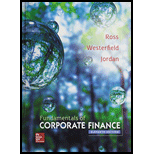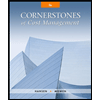
Fundamentals of Corporate Finance with Connect Access Card
11th Edition
ISBN: 9781259418952
Author: Stephen A. Ross Franco Modigliani Professor of Financial Economics Professor, Randolph W Westerfield Robert R. Dockson Deans Chair in Bus. Admin., Bradford D Jordan Professor
Publisher: McGraw-Hill Education
expand_more
expand_more
format_list_bulleted
Concept explainers
Question
Chapter 25, Problem 10CRCT
Summary Introduction
To discuss: How can a share of stock can be replicated using a put price, call price, and a T-bill price.
Introduction:
The put-call parity is the relationship of the prices between the put option, call option, underlying stock, and a riskless asset.
Expert Solution & Answer
Want to see the full answer?
Check out a sample textbook solution
Students have asked these similar questions
A bond’s face value is:
A) The price at which the bond is bought
B) The amount paid to the bondholder at maturity
C) The interest rate of the bond
D) The amount of annual coupon payments
A public company’s value can be calculated by different approaches depending on the data available and are often shared through quarterly or annual reports, or financial statements.
If a financial and investment analyst for a publicly traded company, understanding that I may be asked to give a presentation on how the company uses performance metrics in corporate valuation. How would I present return on equity (ROE) and earnings per share (EPS) to a group of investors or senior management. Reviewiing a publicly traded company’s ROE and EPS. Although What do these results say about the company?
A stock’s beta coefficient is a measure of its:
A) Dividend yield
B) Risk in relation to the market
C) Earnings growth rate
D) Market price
Chapter 25 Solutions
Fundamentals of Corporate Finance with Connect Access Card
Ch. 25.1 - Prob. 25.1ACQCh. 25.1 - Prob. 25.1BCQCh. 25.2 - Prob. 25.2ACQCh. 25.2 - Prob. 25.2BCQCh. 25.3 - Prob. 25.3ACQCh. 25.3 - Prob. 25.3BCQCh. 25.4 - Why do we say that the equity in a leveraged firm...Ch. 25.4 - Prob. 25.4BCQCh. 25.5 - Prob. 25.5ACQCh. 25.5 - Prob. 25.5BCQ
Ch. 25 - Prob. 25.1CTFCh. 25 - Prob. 25.3CTFCh. 25 - Prob. 1CRCTCh. 25 - Prob. 2CRCTCh. 25 - Prob. 3CRCTCh. 25 - Prob. 4CRCTCh. 25 - Prob. 5CRCTCh. 25 - Prob. 6CRCTCh. 25 - Prob. 7CRCTCh. 25 - Prob. 8CRCTCh. 25 - Prob. 9CRCTCh. 25 - Prob. 10CRCTCh. 25 - Prob. 1QPCh. 25 - Prob. 2QPCh. 25 - PutCall Parity [LO1] A stock is currently selling...Ch. 25 - PutCall Parity [LO1] A put option that expires in...Ch. 25 - PutCall Parity [LO1] A put option and a call...Ch. 25 - PutCall Parity [LO1] A put option and call option...Ch. 25 - BlackScholes [LO2] What are the prices of a call...Ch. 25 - Delta [LO2] What are the deltas of a call option...Ch. 25 - BlackScholes and Asset Value [LO4] You own a lot...Ch. 25 - BlackScholes and Asset Value [L04] In the previous...Ch. 25 - Time Value of Options [LO2] You are given the...Ch. 25 - PutCall Parity [LO1] A call option with an...Ch. 25 - BlackScholes [LO2] A call option matures in six...Ch. 25 - BlackScholes [LO2] A call option has an exercise...Ch. 25 - BlackScholes [LO2] A stock is currently priced at...Ch. 25 - Prob. 16QPCh. 25 - Equity as an Option and NPV [LO4] Suppose the firm...Ch. 25 - Equity as an Option [LO4] Frostbite Thermalwear...Ch. 25 - Prob. 19QPCh. 25 - Prob. 20QPCh. 25 - Prob. 21QPCh. 25 - Prob. 22QPCh. 25 - BlackScholes and Dividends [LO2] In addition to...Ch. 25 - PutCall Parity and Dividends [LO1] The putcall...Ch. 25 - Put Delta [LO2] In the chapter, we noted that the...Ch. 25 - BlackScholes Put Pricing Model [LO2] Use the...Ch. 25 - BlackScholes [LO2] A stock is currently priced at...Ch. 25 - Delta [LO2] You purchase one call and sell one put...Ch. 25 - Prob. 1MCh. 25 - Prob. 2MCh. 25 - Prob. 3MCh. 25 - Prob. 4MCh. 25 - Prob. 5MCh. 25 - Prob. 6M
Knowledge Booster
Learn more about
Need a deep-dive on the concept behind this application? Look no further. Learn more about this topic, finance and related others by exploring similar questions and additional content below.Similar questions
- No AI Which of the following is NOT a characteristic of common stock? A) Voting rights B) Dividends C) Guaranteed return on investment D) Ownership in the companyarrow_forwardWhich of the following would be considered an example of an operating activity in a cash flow statement? A) Issuance of common stock B) Borrowing from a bank C) Payment for goods sold D) Purchase of equipmentarrow_forwardNo chatgpt!! What does the Price-to-Earnings (P/E) ratio measure? A) Profit margin B) Dividend yield C) Market valuation relative to earnings D) Return on equityarrow_forward
- I need help in this question!! What does the Price-to-Earnings (P/E) ratio measure? A) Profit margin B) Dividend yield C) Market valuation relative to earnings D) Return on equityarrow_forwardWhat does the Price-to-Earnings (P/E) ratio measure? A) Profit margin B) Dividend yield C) Market valuation relative to earnings D) Return on equityarrow_forwardWhat is the risk-free rate typically associated with? A) Corporate bonds B) Government securities C) Real estate investments D) Equitiesarrow_forward
- No chatgpt! Which of the following financial instruments is used to hedge against interest rate risk? A) Futures contracts B) Treasury bills C) Interest rate swaps D) Corporate bondsarrow_forwardWhich of the following financial instruments is used to hedge against interest rate risk? A) Futures contracts B) Treasury bills C) Interest rate swaps D) Corporate bondsarrow_forwardNeed assistance! Which of the following is the best description of a dividend? A) The amount a company spends on research and development B) A payment made to shareholders from company profits C) The price of a company’s stock D) The cost of producing goods for salearrow_forward
- I need help in this question! Which of the following is the best description of a dividend? A) The amount a company spends on research and development B) A payment made to shareholders from company profits C) The price of a company’s stock D) The cost of producing goods for salearrow_forwardNo AI Which of the following is the best description of a dividend? A) The amount a company spends on research and development B) A payment made to shareholders from company profits C) The price of a company’s stock D) The cost of producing goods for saleNeed help!arrow_forwardDo not use ChatGPT! Which of the following is the best description of a dividend? A) The amount a company spends on research and development B) A payment made to shareholders from company profits C) The price of a company’s stock D) The cost of producing goods for salearrow_forward
arrow_back_ios
SEE MORE QUESTIONS
arrow_forward_ios
Recommended textbooks for you
 Intermediate Financial Management (MindTap Course...FinanceISBN:9781337395083Author:Eugene F. Brigham, Phillip R. DavesPublisher:Cengage Learning
Intermediate Financial Management (MindTap Course...FinanceISBN:9781337395083Author:Eugene F. Brigham, Phillip R. DavesPublisher:Cengage Learning Cornerstones of Cost Management (Cornerstones Ser...AccountingISBN:9781305970663Author:Don R. Hansen, Maryanne M. MowenPublisher:Cengage Learning
Cornerstones of Cost Management (Cornerstones Ser...AccountingISBN:9781305970663Author:Don R. Hansen, Maryanne M. MowenPublisher:Cengage Learning

Intermediate Financial Management (MindTap Course...
Finance
ISBN:9781337395083
Author:Eugene F. Brigham, Phillip R. Daves
Publisher:Cengage Learning

Cornerstones of Cost Management (Cornerstones Ser...
Accounting
ISBN:9781305970663
Author:Don R. Hansen, Maryanne M. Mowen
Publisher:Cengage Learning
Efficient Market Hypothesis - EMH Explained Simply; Author: Learn to Invest - Investors Grow;https://www.youtube.com/watch?v=UTHvfI9awBk;License: Standard Youtube License